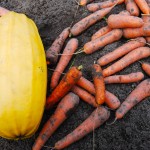 By Alma Copeland, Home Economist
By Alma Copeland, Home Economist
TEAM Resources
Pumpkins, winter squash and root vegetables can easily be stored for winter use. Even apartment dwellers can be successful at storing some vegetables for even part of the winter in the apartment/condo. If the vegetable likes a cold storage area, squeezing them into the refrigerator can be a worthwhile plan.
Pumpkins and winter squash: To store successfully, these vegetables must be mature and have a hard rind. If you cannot sink you fingernail easily into the rind, the pumpkin is ready for storage. Preferably leave the pumpkins in the garden until the rinds have hardened, then put them in storage. If you must bring them in earlier, leave them at room temperatures for a few weeks until the rind hardens. Store in a cool room 10°C (50°F) with low humidity and in dry conditions.
Ripening pumpkins: Green pumpkins will ripen with sunlight, warmth and time. Just follow these steps:
- Remove the pumpkin from the patch and wash off the dirt.
- Place on a warm sunny deck or patio.
- They can also be brought inside. If you bring them inside, make sure there is good air circulation to minimize the chance of mold and rot.
- Turn the greenest side of the pumpkin towards the sun.
- Rotate the pumpkin from time to time to allow the sun to reach the greener parts of the pumpkin.
- If left outdoors, bring them in at night to keep the pumpkins’ temperature warmer.
Onions like a cold, dry storage. Dig them before a heavy frost and dry them very thoroughly. Hanging them up in a shed or garage, or lay them outside on hot windy days can do this. Commercial growers dig and top the onions, then blow hot, dry air through them to make sure they dry quickly and completely. Once dry, the onions are stored at 1°C (34°F) under very dry conditions. Potatoes store best at cold temperatures, but not colder than 2.5°C (36.5°F). Colder temperatures cause potatoes to convert starch into sugar, resulting in a sweet-tasting potato. Before putting your potatoes in storage, store them for about two weeks at cool 13°C (55°F) under moist conditions. Potatoes must be stored in the dark, as even a small amount of light can cause them to become bitter. After two weeks at cool temperatures, they are ready to store in the dark at 2.5 to 4.5°C (36.5 to 40°F) and under high humidity. Warmer temperatures allow the tubers to sprout, and low humidity causes dehydration.
Turnips, carrots, parsnips and beets require near freezing temperatures 0 to 2.5°C (32 to 36.5°F) and high relative humidity. They like it cold and damp. Some people place clean, mature vegetables in slightly damp peat moss or plastic bags. If you store potatoes and root vegetable together, place the potatoes on a shelf, where the temperatures will be a few degrees warmer and the root vegetables on the floor (colder area).
Source: Hort-Hints III, Extension Division, University of Saskatchewan.






